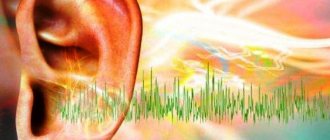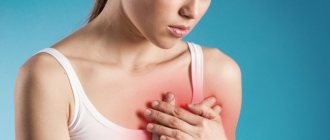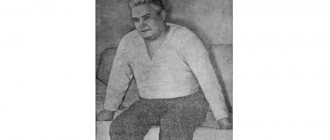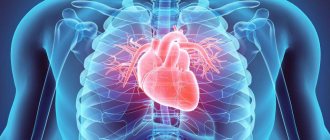VSD of the cardiac type: what is it?
VSD of the cardiac type is one of the types of disorders in the functioning of the nervous system, in which the vessels lose or, on the contrary, increase their normal tone. For this reason, problems arise with the functioning of other organs and systems of the human body.
The scenario for the development of cardiac type VSD occurs as follows:
- the nervous system becomes unstable;
- she actively reacts to any stimuli;
- there is an imbalance of all regulators;
- the functioning of internal organs changes;
- The body's systems respond to this process with intense stress.
Various forms of VSD are manifested by individual symptoms, most often from the heart, blood vessels, endocrine and respiratory systems of the body. Cardiac dystonia does not indicate the presence of organic damage to the heart, but a current malfunction in the central nervous system.
This condition cannot be called life-threatening, but over time, without appropriate therapy, it can provoke the development of a number of complications.
Prevention
Swimming pool recommended
It is possible to defeat VSD, but it is a long process. For prevention, you must adhere to the following rules:
- do not smoke or drink alcohol;
- sleep 8 hours a day;
- going to bed no later than 23:00;
- regular exercise;
- walks in the open air;
- adherence to daily routine;
- combating stress.
Breathing practices, meditation, and yoga are used to combat stress. If this does not help, taking medications is allowed, since chronic stress weakens the nervous system and the entire body as a whole.
Exercise is good for the health of the nervous system. For VSD of the cardiological type, Nordic walking, jogging, exercises on the orbit track, and swimming are indicated.
You can also take a course of B vitamins twice a year and undergo a preventive course of relaxing massage.
Symptoms of the disease and its diagnosis
VSD of the cardiac type has varied symptoms, most of them are associated with manifestations of the functioning of the heart and blood vessels.
Signs of the disease:
- the appearance of headaches, fatigue that occurs for no particular reason;
- disturbance of heart rhythm, expressed in acceleration or deceleration of indicators;
- pain often occurs in the area of the heart, it can be different: pressing, stabbing, burning or aching;
- constant weakness;
- frequent situations of increased blood pressure (see here) or decreased numbers;
- the occurrence of chills and a feeling of freezing of the fingertips of the upper and lower extremities;
- dependence of mood and well-being on changes in weather conditions;
- increased normal sweating;
- poor health when the level of physical activity increases;
- problems with sleep and appetite;
- lack of reactions from the body after taking Nitroglycerin.
The nervous system can produce reactions in cardiac dystonia due to the following provoking factors:
- constantly being in a state of stress;
- changes in hormone levels;
- pregnancy;
- menses;
- menopause;
- puberty.
Diagnosis of VSD is carried out through studies that help to exclude or confirm pathological changes in the functioning of the cardiovascular system. The same symptoms as with cardiac dystonia can manifest heart defects, arrhythmias and myocarditis, cardiomyopathies and angina.
To clarify the patient’s health status, the specialist prescribes the following types of studies:
- Taking an electrocardiogram, including daily duration.
- Carrying out cardiac exercise tests.
- Ultrasound examination of the heart using Doppler.
- In rare cases: coronary angiography or scintigraphy.
- Examination by a neurologist.
Therapy technique
Treatment of vegetative-vascular dystonia should be aimed at eliminating symptoms and correcting the psychological health of the victim. First of all, the recommendations of the attending physician motivate the patient to make a huge change in lifestyle, frequent recreation in nature, giving up bad habits, periodically visiting a psychotherapist and establishing a correct and healthy diet enriched with foods.
It is recommended to eat foods that contain a lot of potassium and magnesium (these elements help improve blood circulation, restore proper heart function and prevent blood clots). Products that are useful and recommended in the presence of VSD:
- buckwheat and oatmeal;
- ingredients from the legume group;
- peas;
- green onions;
- carrot;
- all types of nuts;
- honey;
- raisins and dried apricots;
- eggplants.
In addition to adjusting the diet and visiting a qualified psychologist, the cardinal type of vegetative-vascular dystonia can be treated with the help of pharmacological drugs:
- sedatives (eliminate attacks of neuropsychic abnormalities);
- tranquilizers (produce a calming effect on the patient);
- antidepressants (help cope with fears, anxiety and restlessness);
- vasodilating medications (help improve blood supply);
- beto-blockers (cope with manifestations of tachycardia, arrhythmia and bradycardia);
- adaptogens (significantly strengthen the resistance of the human body).
All described pharmacological agents must be prescribed by a qualified doctor who, based on the results of a diagnostic examination, will be able to take into account the individual characteristics and abnormalities of the victim’s body.
In addition to drug treatment, therapeutic procedures are used:
- physiotherapy;
- specialized massage course;
- acupuncture;
- Charcot's shower;
- periodic use of contrast showers.
Charcot's shower for nervous diseases and stress
If you adhere to the existing recommendations of experienced specialists and begin treatment for vegetative-vascular dystonia of the cardiac type, you can effectively cope with the progression of the disease.
Factors provoking the development of VSD
To provoke the development of dystonia, the presence of certain factors is necessary. They are conventionally divided into internal and external, and the presence of a cardiac type of VSD is not at all an indicator that the factors will be associated with heart disease.
External factors:
- strong human susceptibility to stress and anxiety;
- neglect to comply with reasonable rules regarding sleep, nutrition, work and rest;
- presence of bad habits;
- consequences of severe physical stress;
- unfavorable environmental situation in the place of residence;
- consequences of injuries or illnesses;
- frequent situations in which a person experiences special emotional stress;
- constant overheating or hypothermia.
All these factors differ in that their presence in a person’s life requires him to seriously overstrain, fraught with negative consequences for the nervous system.
Internal factors:
- temperament subtype (for example, dystonia is more often diagnosed in melancholic and choleric people);
- increased anxiety, vulnerability or suspicious character;
- the time when a change in the constant amount of hormones occurs (this pathology in pregnant women, adolescents and women during menopause is more common than in middle-aged people);
- influence of heredity;
- a small proportion of physical activity in life.
The influence of the causal factor is of great importance. For dystonia to develop, there must be some kind of push, for example, severe stress experienced by a person.
Reasons for the development of dystonia
The main factors contributing to the development of such a disease in a person:
- Primary disorders of the autonomic nervous system.
- Unfavorable hereditary predisposition.
- Prolonged stress.
- A person’s emotional constraint, when for various reasons he does not show his feelings, holds them back within himself.
- Intense physical activity.
- Some personality characteristics (for example, anxiety, suspiciousness or accentuation).
- Insufficient physical activity.
In addition, there are also predisposing factors that can cause this disease:
- disorder of the central nervous system;
- various dysfunctions in the functioning of the endocrine glands;
- heart diseases;
- allergic reactions;
- immune system disorder;
- frequent bacterial or viral diseases;
- poisoning;
- abuse of sunbathing;
- frequent hypothermia;
- alcohol and smoking abuse;
- harmful working conditions;
- traumatic brain injuries.
Against the background of these phenomena, homeostasis dysfunction in the body gradually occurs. This activates tissue hormones such as catecholamines, serotonin, and histamine. These processes contribute to metabolic disorders and microcirculation. There is a disorder in the functioning of cells, which contributes to the deterioration of the activity of the autonomic nervous system.
Treatment of the disease
Treatment of dystonia developing of the cardiac type can begin immediately after comprehensive diagnostic measures have been carried out to confirm this diagnosis.
Most often, the doctor prescribes the following medications:
- tranquilizers: increasing blood pressure, stabilizing the central nervous system (Relanium);
- sedatives: relieving stress, elevating mood and eliminating anxiety (Motherwort, Valerian);
- nootropics: increasing the brain’s ability to withstand periods of oxygen starvation (Piracetam);
- antidepressants: improving mood and relieving symptoms of depression (Anaprilin);
- cerebroprotectors: activating cerebral blood flow (Cavinton);
- beta-blockers: acting as stabilizers of the central nervous system and normalizing heart rhythm (Betalok);
- cholinomimetics: returning the heart rate to physiological norms (atropine).
In the treatment of this disease, physiotherapeutic procedures are very important:
- Electrophoresis, which uses Novocaine, will help relieve pain.
- The massage will relax tense muscles and improve blood circulation in the cervical region, stimulating brain function.
- Charcot's shower (or an ordinary contrast shower) will normalize blood pressure and improve the functioning of the entire autonomic nervous system.
- Acupuncture and reflexology will help relieve discomfort and relieve headaches.
- Exercise therapy and breathing exercises will help maintain a calm state and resist external stress.
- Classes with a psychotherapist will teach you methods of relieving anxiety.
- Sanatorium treatment will help to improve the health of the entire body and increase the defenses of the immune system.
Establishing nutrition for VSD can completely change the well-being of a dystonic patient for the better.
Features of nutrition for VSD:
- inclusion in the daily diet of foods that strengthen the heart muscle (honey, dried apricots, raisins);
- to improve the supply of nutrients to the myocardium, regularly eat bananas rich in potassium;
- maintain a sufficient amount of magnesium in the body, which is necessary for the proper functioning of the heart muscle (by consuming cereals and legumes);
- be sure to include hazelnuts, almonds, spinach and watermelons in your diet;
- regularly replenish the amount of iodine in the body by eating seafood;
- do not forget about maintaining immunity, for which it is important to supply the body with vitamins C, D and A contained in fruits, grains and vegetables;
- limit the amount of fried, spicy, rich meat dishes you consume.










